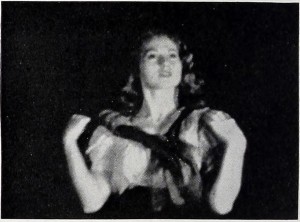
"In The Alpine Vixen, a dramatic story based on folklore legend, Anchor 0. Jensen has raised 8mm. color filming to a level that movie makers in any width would do well to emulate. Particularly in the double exposed sequence of the Titian haired girl in a cave of crystals does he prove his skill with the camera. Mr. Jensen also achieves unusually pleasant outdoor lighting, both in close shots and more distant scenes. The film is accompanied by a narrative, to clarify the pictured story, interspersed with a folk tune played on an accordion, all of which is recorded on a sixteen inch disc. One might have hoped for more somber music to match the menacing mood of the early part of the film, but the accordion tune is in keeping with the climactic scenes of the festive villagers. Infelicities of modern accouterments which would have marred the spirit of the legendary tale have been judiciously avoided." Movie Makers, Dec. 1945, 494.
"a ghost story, dealing partly with Victorian times and partly with the present day" (HMHT 1934: 490)
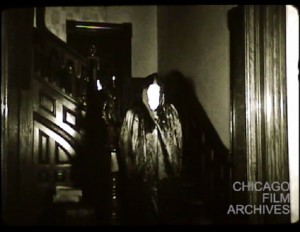
"A short mystery film from members of the Amateur Cinema League. A group of relatives gather in a haunted house for the reading of a will. Someone among them knows a secret about the house, and uses stories about the Black Widow to try and scare everyone away. In the end, their identity is revealed and all the secrets come to light. Title cards narrate the dialogue." Chicago Film Archives.
Visitors at a party receive a message from beyond that informs them, "There is a devil here!" and chaos follows. ‘Just before he died, the photographer of this film, Jack O' Hea, saw an article by Tony Rose, FACI, about the very first year of the Ten Best Competition and so this 'lost' film was rediscovered. It was made in 1934, just two years after Kodak had introduced the 8mm gauge. Music and 'devilish sound effects' were added by Jack O'Hea in 1978. These were revised and re-tracked for the IAC Library by the late Leslie Germany, FACI. The story, by John Burke, relates how the visitors at the Blackmores' party (one of whom is played by the director, Stanley Comber) receive a spirit-message that: 'There is a devil here!'. They link hands round the table and the hostess is attacked’ (EAFA Database).
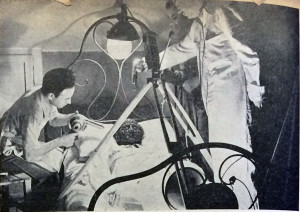
"a soggetto breve"/short fiction based on the eponymous novel by Edgar Allan Poe
"Christmas Nuts, presented with a sound on film recording on a separate 16mm. film, produced by Paul Braun and Howard Goodman, is not only an interior color picture of exceptional beauty and impeccable technical quality but is also one of the best puppet films thus far created. With a camera technique paralleling that of the latest theatrical, animated talkie cartoons, the story of a wolf "hijacking" Santa Claus and the consequent near calamity for the two squirrels is unfolded in a completely cinematic fashion. The camera moves freely from medium shot to closeup, the mechanics of the sets are not obstrusive and the puppets move with agility and grace. The sets, which were designed and constructed with great care, are very handsome and exquisitely finished so that no imperfections are revealed in the enlarged picture of them on the screen. The sets, in combination with the colored lights used in part to illuminate them, embody the producers' theory of "created color." That is, no attempt is made to simulate nature, but rather to produce pleasing, vivid color combinations, as in the illustrations of a child's story book. A cleverly compiled dialog, song and music accompaniment has been synchronized with the picture, although recorded, at present, on a separate film." Movie Makers, Dec. 1935, 534.
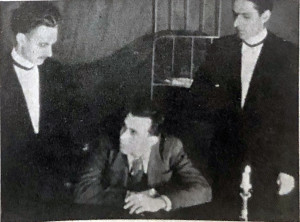
From the eponymous novella by Edgar Allan Poe
"II cuore rivelatore, realizzato da Alberto Mondadori, collaboratore Mario Monicelli, scenografia di Alberto Lattuada, operatore Cesare Civita; da un racconto di Edgar Allan Poe. lnterpreti Giuseppe Pedrini, Giuliano Carta. Abbiamo accennato tempo fa ad un film sperimentale americano sullo stesso soggetto, dovuto a R. P. Cobb. Interessante appare iI confronto con questo di Mondadori; in definitiva quello appare più surrealista, questo e invece più incisivo e reale preoccupandosi piuttosto Mondadori di creare l'atmosfera allucinata con uso non eccessivo di puri espedienti tecnici; ne consegue una maggior chiarezza nel racconto cinematografico, che procede abbastanza sostenuto anche per la buona interpretazione. Il regista non ha rinunciato tuttavia a quegli espedienti tecnici, come sovrimpressioni, ma ne ha usato in modo conveniente, senza esagerazioni . E' infine da tener presente l'intendimento di tentare nel campo della produzione italiana a passo ridotto, un genere diverso da i consueti."
"II cuore rivelatore (The Tell-Tale Heart), directed by Alberto Mondadori, with the collaboration of Mario Monicelli, set design by Alberto Lattuada, cameraman Cesare Civita, based on a story by Edgar Allan Poe. Some time ago, we mentioned to an American experimental film on the same subject by R. P. Cobb. Comparing it with this of Mondadori proves interesting; ultimately, that one appears more surrealist, while this one is instead more incisive and real since Mondadori concerns himself with creating the hallucinated atmosphere through a not excessive use of pure technical expedients; a greater clarity in the cinematographic story follows, which moves forward in a sustained enough fashion also for the good acting. The director has not abandoned himself to those technical expedients, such as superimpositions, but he has used them in a suitable way, without exaggerations. It is important, finally, to keep in mind the intention to try in the field of small-guage Italian production, a different genre from the usual."
—Il Ventuno 28 (Review of the G.U.F. of Venice), May 1935
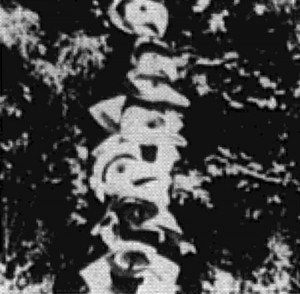
"Raven and his creation of the world and its inhabitants is an old Indian legend. This version is skillfully portrayed in pantomime, costume and setting. The grace and skill of the actors, an excellent narration and music score, combined with imaginative use of the camera, make this an engrossing experience for the audience. One of the Ten Best, this film was awarded the Northern California Council of Amateur Movie Clubs' Trophy for the best scenario film and will be included in the package" PSA Journal, Oct. 1963, 40.
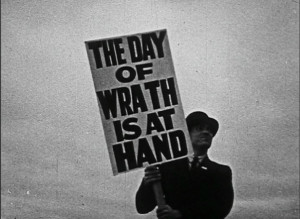
"Science fiction film influenced by the style of inter-war European art cinema." East Anglian Film Archive.
"Each year the contest sponsored by the American Society of Cinematographers through this magazine seems to bring forth a surprise. For several years the 8mm cinematrographers have been setting the pace, but never has any of them reached the goal achieved this year by Miss Ruth Stuart. Miss Stuart has been a contributor to this contest every year for the past three years; in 1933 she was given the medal for travel pictures. Her 200 ft. 16mm subject 'Doomsday' was also awarded honors in the British Institute of Amateur Cinematographers. In the American Society of Cinematographers contest just closed she was given a recognition for the Outstanding picture, in photography and Documentary pictures. It will be surprising to many that this unusual honor should befall a woman. Photography, by the unwritten law, is supposedly the realm of male species. Miss Stuart, however showed such a fine understanding of the value of pictures that move, how to fabricate these moving photographs into an interesting document that would hold any audience anywhere in the civilized world. For a person who films she must have developed a stony heart in order to cut as judiciously as the picture indicates. There is a tempo to the production that is very seldom achieved by an amateur. There are no obvious pet shots or scenes. Each sequence, each scene, each picture was left in production for a purpose to give it atmosphere to help the story along." American Cinematographer, Jan. 1937, 25.
"Well photographed, well planned film dealing with the contrasted fears of town and country folk and their reaction to catastrophe" (IAC 1975).
‘A fantasy based upon a fear which has preyed upon credulous minds from the beginning of time' is the maker's description of this ambitious attempt to show how people react to the possibility of a catastrophe and then to the real event. The story hinges upon a cosmic event that upsets the Earth's equilibrium, causes an imbalance of weather conditions and other natural forces, resulting in widespread panic’ (EAFA Database)."
"The film opens at the Atheneum Club where members are playing cards. They talk about a man named Pierpont who has an interest in the supernatural and has invited them to a séance the following day. At the séance Pierpont welcomes the visitors and introduces a man called Horace who will be the séance medium. Having set the scene by playing music and dimming the lights, Pierpont hypnotizes Horace and puts him into a wooden box. The séance continues with questions being asked to Horace in the box. When there is no answer, Pierpont opens the box and announces that Horace is dead. The horrified guests leave and find the police. On their return to the room, they find that the body is missing and Pierpont is questioned. Horace returns to the room alive and one of the guests remarks that this should be a lesson to them all" (MACE Online Archive).
Total Pages: 4